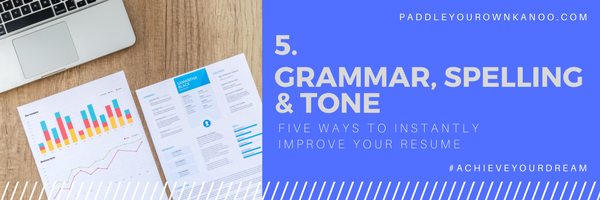Writing a resume from scratch can be a long and time-consuming task – we like to think of a resume as a ‘living document’. One that you should be constantly reviewing, adapting and improving upon. Getting it right first time is a mere pipe dream for most job hunters.
So if you’ve already got a draft of your resume or perhaps one that you haven’t updated in months (maybe even years) then this article is for you. Of course, we would always argue that rushing an update to your resume is not a good idea – it takes time and patience to craft a winning application after all.
But sometimes, time is something you don’t have. When an application deadline is fast approaching and you’ve only got hours and not days to improve your resume, these five tips will instantly transform your resume.
1. Use a modern template
When we say, “use a modern template” we don’t mean “use a fun, whacky, colourful or standout template.” There are lots of different resume template services on the internet – most of which format your resume in a way that might look good but which won’t impress a recruiter.
Your template should do two things:
- Formatted to be correctly parsed by an Applicant Tracking System (ATS)
- Look professional and conservative
We have six free templates that do both these things. You can download the templates here. They’re stripped of bloat, well-formatted, compatible with all major word-processing programmes and designed to appeal to the conservative tastes of recruiters.
If you decide to create your resume from scratch, follow these guidelines:
- Use a simple, sans-serif font
- Keep font size between 10-12
- Avoid using tables, pictures, charts, etc.
- Keep spacing consistent throughout the document
- Only use colour very sparingly
The end result might look boring but unless you’re applying for a creative industry role, this really is how you want it to look. You want to stand out by the content of your resume not by how colourful it looks.

2. Identify and use keywords
Ideally, your resume should be tailored for the job you’re applying for. Every job will have a specific list of requirements and recruiters will know what type of person they are looking for. An ATS will effectively scan your resume and check off as many of those items off the list – if you don’t score enough points, then your application won’t be taken any further. It’s as simple as that.
At the very least, your resume should be tailored to the industry you’re wanting to work in. Trying to write a ‘one size fits all’ resume is unlikely to generate much success. But once you’ve got your industry-specific resume, you can easily tailor it to individual jobs.
Read through the job ad and identify specific requirements and keywords. Carefully go through your resume and see how many of those keywords you already have. In some places, you might be able to simply change a word or two. In others, you may have to write specific examples.
You don’t have to hit every keyword – especially if you don’t have the experience to back it up – recruiters don’t expect applicants to be perfect in every way.
3. Be creative with your experience
By no means does this mean lying or being economical with the truth. Putting a well-intentioned lie in your resume is a surefire way to lose both the job and any chance of ever being hired by the company in the future.
That being said, sometimes you need to think about your experience from a different point of view. Chances are you have the skills the recruiter is looking for but the way you’ve written about your experience is doing a really lousy job of proving this.
If you are definitely lacking essential experience then there might be some quick fix solutions. Taking an online course, doing voluntary work or an internship are easy, fast and cheap ways to gain valuable experience which will give your resume an edge.

4. Use specific examples
This is the one thing that is lacking from so many resumes – and yet including specific examples that prove you have the experience you claim to have – is what recruiters want to see more than anything.
One of the easiest ways to do this is by including an ‘achievements’ section on your resume – ideally under each job role. Including two standout achievements that use specific examples will have a big impact on a recruiter.
If possible, don’t limit specific examples to just an ‘achievements’ section – every skill you claim to have should be backed up with an example of where you’ve used that skill or gained that experience. Simply saying you have the experience is not good enough.
But when time is of the essence, focus on achievements and really key skills that you definitely need to possess to land the job.
5. Grammar, spelling and tone
This is fairly self-explanatory right?! But even as professional resume writers we occasionally find erroneous spelling and grammar mistakes in the resume’s we write. Using the inbuilt tools on a good word processing system is a good start but don’t rely on these.
It’s also far too easy to skim read over the resume you’ve just written. The mind plays tricks on us and mistakes are easily overlooked. Once you’ve written your resume, take a break and then go back to it. Read through every sentence, one at a time and be aware of common grammatical mistakes:
- They’re, their, there
- Your, you’re
- Its, It’s
- Affect, effect
- To, too
- Of, have
- Less, Fewer
- Compliment, complement
…And so many others that we could write an entire article on. We highly recommend using a smart grammar checker like Grammarly to double check your writing. The free version should be suitable for most people although there’s a premium option which will supercharge your resume.
Finally, choose a tense and voice for your resume and stick to it. We recommend past tense and third person.







